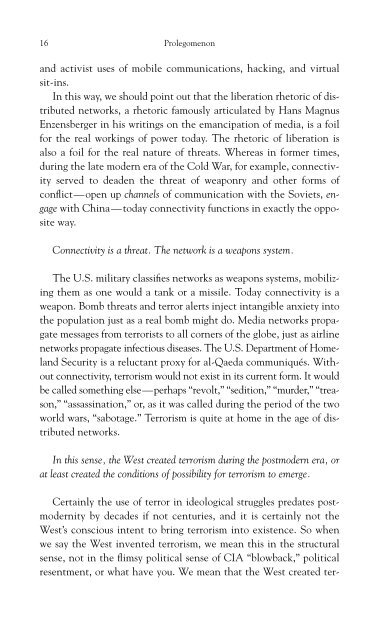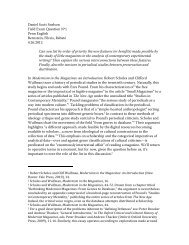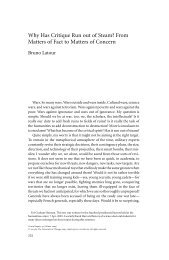The Exploit: A Theory of Networks - asounder
The Exploit: A Theory of Networks - asounder
The Exploit: A Theory of Networks - asounder
Create successful ePaper yourself
Turn your PDF publications into a flip-book with our unique Google optimized e-Paper software.
16 Prolegomenon<br />
and activist uses <strong>of</strong> mobile communications, hacking, and virtual<br />
sit - ins.<br />
In this way, we should point out that the liberation rhetoric <strong>of</strong> distributed<br />
networks, a rhetoric famously articulated by Hans Magnus<br />
Enzensberger in his writings on the emancipation <strong>of</strong> media, is a foil<br />
for the real workings <strong>of</strong> power today. <strong>The</strong> rhetoric <strong>of</strong> liberation is<br />
also a foil for the real nature <strong>of</strong> threats. Whereas in former times,<br />
during the late modern era <strong>of</strong> the Cold War, for example, connectivity<br />
served to deaden the threat <strong>of</strong> weaponry and other forms <strong>of</strong><br />
conflict—open up channels <strong>of</strong> communication with the Soviets, engage<br />
with China—today connectivity functions in exactly the opposite<br />
way.<br />
Connectivity is a threat. <strong>The</strong> network is a weapons system.<br />
<strong>The</strong> U.S. military classifies networks as weapons systems, mobilizing<br />
them as one would a tank or a missile. Today connectivity is a<br />
weapon. Bomb threats and terror alerts inject intangible anxiety into<br />
the population just as a real bomb might do. Media networks propagate<br />
messages from terrorists to all corners <strong>of</strong> the globe, just as airline<br />
networks propagate infectious diseases. <strong>The</strong> U.S. Department <strong>of</strong> Homeland<br />
Security is a reluctant proxy for al - Qaeda communiqués. Without<br />
connectivity, terrorism would not exist in its current form. It would<br />
be called something else—perhaps “revolt,” “sedition,” “murder,” “treason,”<br />
“assassination,” or, as it was called during the period <strong>of</strong> the two<br />
world wars, “sabotage.” Terrorism is quite at home in the age <strong>of</strong> distributed<br />
networks.<br />
In this sense, the West created terrorism during the postmodern era, or<br />
at least created the conditions <strong>of</strong> possibility for terrorism to emerge.<br />
Certainly the use <strong>of</strong> terror in ideological struggles predates postmodernity<br />
by decades if not centuries, and it is certainly not the<br />
West’s conscious intent to bring terrorism into existence. So when<br />
we say the West invented terrorism, we mean this in the structural<br />
sense, not in the flimsy political sense <strong>of</strong> CIA “blowback,” political<br />
resentment, or what have you. We mean that the West created ter-









